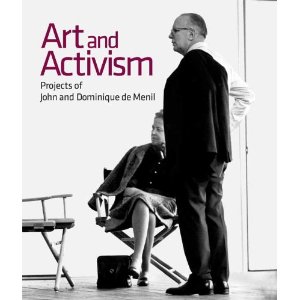It’s fashionable among some critics nowadays to bemoan exhibitions of art owned by one collector. I disagree. Not every collector should be given the honor, of course, and certainly not every collection, but true collectors are very thoughtful about their purchases, and they provide an interesting and often instructive lens through which to view art.
 A perfect contemporary example is documented in a new book, Art and Activism: Projects of John and Dominique de Menil, published by the Menil Collection. Officially out yesterday, the illustrated book examines what the de Menils did for art, architecture, film, and human rights in Houston, where they settled after leaving France in 1941. Their collection is considered to be one of the world’s best private collections — and nary a critic complains about seeing it on view in the museum they founded in Houston. Many make pilgrimages to it.
A perfect contemporary example is documented in a new book, Art and Activism: Projects of John and Dominique de Menil, published by the Menil Collection. Officially out yesterday, the illustrated book examines what the de Menils did for art, architecture, film, and human rights in Houston, where they settled after leaving France in 1941. Their collection is considered to be one of the world’s best private collections — and nary a critic complains about seeing it on view in the museum they founded in Houston. Many make pilgrimages to it.
So, it’s no surprise that, as a Houston Chronicle article on Sunday said:
Art and Activism is an indispensable history of several pivotal decades in the development of Houston’s art scene. That it hits bookstores while an exhibition sampling the Menil’s acquisitions since 2004 remains on view is especially timely, since Art and Activism addresses some questions about why the Menil – and for that matter, the city’s art world – is the way it is, while shedding light on what it’s becoming.
After relating the story of the couple’s successful attempt to bring great art to Houston’s black areas in the early 1970s, the Chronicle’s Douglas Britt writes:
So much in that story is vintage de Menil: the willingness to follow artists’ and activists’ leads. The belief that art could empower black Americans without requiring separatism or compromising quality. The desire to attract important artists and thinkers to the city they were helping transform. The will and means to move quickly to make big things happen. The eclectic nature of their interests, which included, among other areas, both American abstract painting and the art of indigenous peoples. The mystical insistence on letting objects and viewers communicate directly, neither assisted nor impeded by explanatory texts, even as the de Menils were consumed with one of their most important educational endeavors, the founding of art, art history, exhibition and film programs at Rice University.
This is a couple that is worth understanding.
You can learn more about the book from the Menil Collection’s press release.
